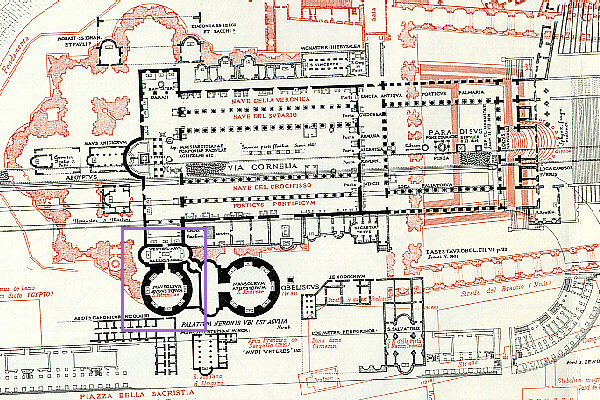
Porta Appia (Rome: reconstructed 400).
| |

Sarcophagus of the Empress Maria
This is the last imperial artifact of ancient Rome. Burial of the sarcophagus containing the remains of Maria, the first wife of the Emperor Honorius, occurred circa 400 A.D. within the Mausoleum of Honorius, a structure then newly attached to the south transept of the original Basilica of Saint Peter.
| |

Honorius built a mausoleum c.400 for himself and his family. It attached directly to the south transept of St. Peter's Basilica, and was next to a pagan aristocratic tomb of the third century. The practice of attaching burial mausolea-chapels to major shrines was not unusual during late antiquity and early medieval times. In the middle of the eighth century, Popes Stephen II (752-7) and Paul I (757-67) took over the Mausoleum of Honorius, and converted it into the church of St. Petronilla. During the sixteenth century, the mausoleum, along with the original St. Peter's, was destroyed to make way for the present basilica.
The only sketches which have reached us represent a few perfume bottles found inside the grave. Of these flacons there are two sets of drawings, one in a codex of marchese Raffaelli di Cingoli, f.43, with the legend, "Five goblets of agate discovered in the foundations of S. Peter's during the pontificate of Paul III. in the tomb of Maria, daughter of Stilicho and wife of Honorius;" the other in the codex of Fulvio Orsino, No. 3439 of the Vatican Library.
>
The discovery took place in 1544. A greater treasure of gems, gold, and precious objects has never been found in a single tomb. The beautiful empress was lying in a coffin of red granite, clothed in a state robe woven of gold. Of the same material were the veil, and the shroud which covered the head and breast. The melting of these materials produced a considerable amount of pure gold, its weight being variously stated at thirty-five or forty pounds. Bullinger puts it at eighty, with manifest exaggeration. At the right of the body was placed a casket of solid silver, full of goblets and smelling-bottles, cut in rock crystal, agate, and other precious stones. There were thirty in all, among which were two cups, one round, one oval, decorated with figures in high relief, of exquisite taste, and a lamp, made of gold and crystal, in the shape of a corrugated sea-shell, the hole for the oil being protected and concealed by a golden fly, which moved around a socket. There were also four golden vases, one of which was studded with gems.
In a second casket of gilded silver, placed at the left side, were found one hundred and fifty objects, — gold rings with engraved stones, earrings, brooches, necklaces, buttons, hair-pins, etc. covered with emeralds, pearls, and sapphires; a golden nut, which opened in halves; a bulla which has been published in a special work by Mazzucchelli; and an emerald engraved with the bust of Honorius, valued at five hundred ducats. Silver objects were scarce; of these we find mentioned only a hairpin and a buckle of repoussé work.
The letters and names engraved on some pieces prove that they formed the mundus muliebris (wedding gifts) and toilet articles of Maria, Daughter of Stilicho and Serena, sister of Thermantia and Eucherius, and wife of the emperor Honorius. Besides the names of the four archangels — Raphael, Gabriel, Michael and Uriel — engraved on a band of gold, those of Domina Nostra Maria, and of Dominus Noster Honorius, were seen on other objects. The bulla was inscribed with the names of Honorius, Maria, Stilicho, Serena, Thermantia, and Eucherius, radiating in the form of a double cross with the exclamation "Vivatis!" between them. With the exception of this bulla, which was bought by Marchese Trivulzio of Milan, at the beginning of the present century, every article has disappeared. That the gold was melted, and that the precious stones were disposed of in various ways, so as to deprive them of their identity, is easy to understand, but where have the vases gone? Were it not for the rough sketches made at the time of the discovery we should not be able to form an idea of their beauty and elegance of shape. They were not the work of goldsmiths of the fifth century, but were of classical origin; in fact they represent a portion of the imperial state jewels, which Honorius had inherited from his predecessors, and which he had offered to Maria on her wedding day. Claudianus, the court poet, described them expressly as having sparkled on the breast and forehead of empresses in bygone days.
We know from Paul Diaconus that Honorius was laid to rest by the side his empress; his coffin, however, has never been found. It must still be concealed under the pavement of the modern church at the southern end of the transept, near the altar of the crucifixion of S. Peter.
Rodolfo Lanciani, Pagan and Christian Rome (New York: Houghton, Mifflin and Company, 1892), p. 203-205.
|